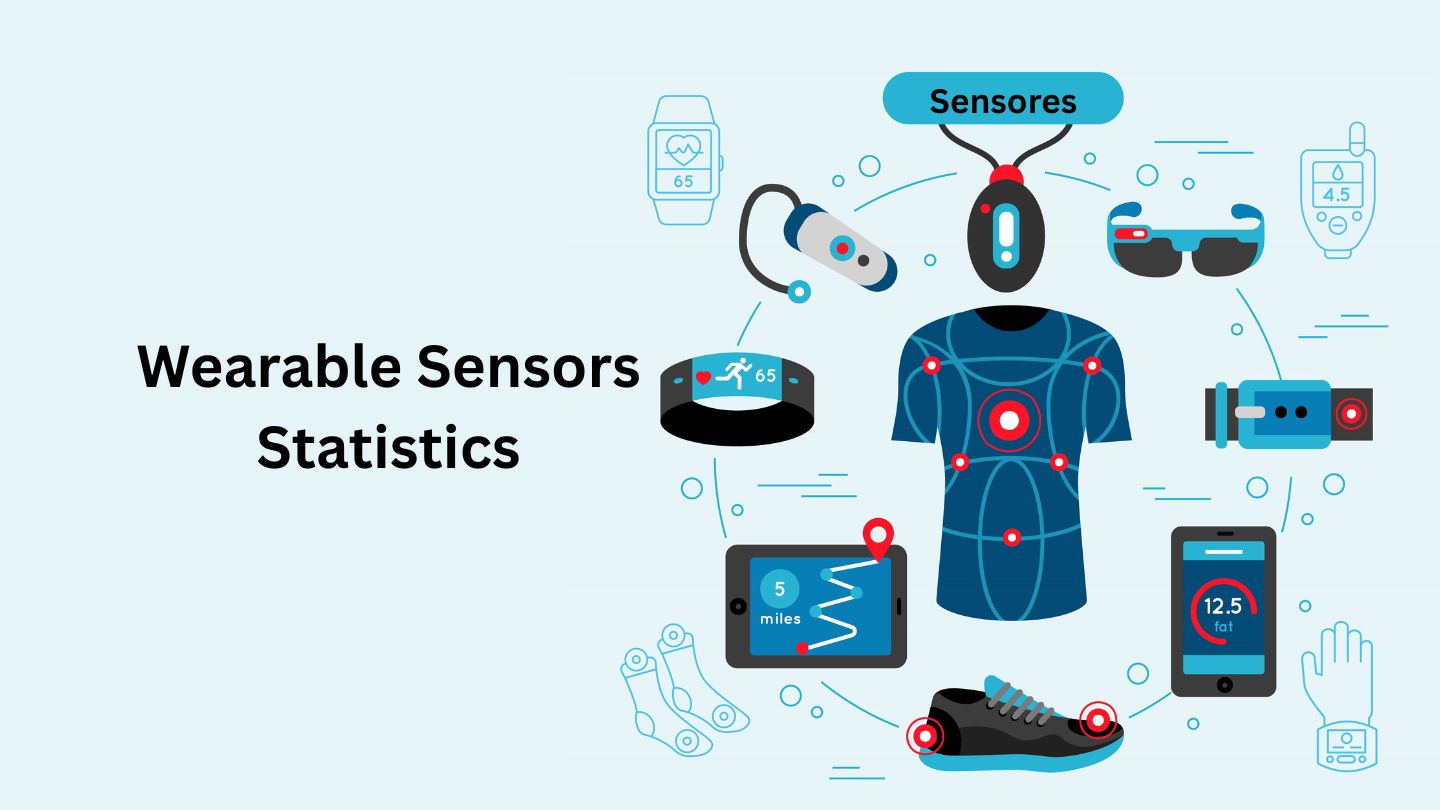Virtual Reality Statistics By Market Size, Adoption Rate, Education, Training, Demographics And Future

Updated · Mar 05, 2025


TABLE OF CONTENTS
- Introduction
- Editor’s Choice
- What is Virtual Reality?
- General Virtual Reality Statistics
- Virtual Reality Market Size Projection
- Virtual Reality Adoption Rate Statistics
- Virtual Reality Headset Statistics
- Virtual Reality in Education And Training
- Industry Affected By the Introduction of Virtual Reality
- Virtual Reality Statistics by Demographics
- Virtual Reality in the Healthcare Market
- Future Of Virtual Reality Statistics
- Conclusion
Introduction
Virtual Reality Statistics: Virtual Reality (VR) has long been viewed as a technology that did not fully meet expectations. However, new data shows that VR is improving rapidly, and its future looks bright. After years of progress, businesses from different industries are now using VR, and many companies are eager to explore its possibilities.
This article shares important Virtual Reality Statistics and insights to keep readers informed about VR’s growth. From its role in the fashion industry to its use in top learning management systems (LMS), these numbers show how VR technology can make a big impact in many areas.
Editor’s Choice
- The worldwide VR market reached approximately USD 67.66 billion in 2024, reflecting its rapid growth and potential.
- An estimated 77 million people in the United States are anticipated to use VR in 2024, marking a 5% increase from the previous year.
- More than 171 million people globally use virtual reality. In North America, the number of VR users is anticipated to hit 65.9 million in 2023.
- Many US consumers view VR positively, even if they don’t own a headset: 37% are excited about VR experiences, and 43% are willing to use it if the conditions are right.
- Virtual Reality Statistics stated that the biggest reason people don’t buy VR devices is their high price (46%).
- The global VR market for consumer applications is expected to hit USD 10.9 billion by 2023, and the VR entertainment market is estimated to reach USD 12.2 billion by 2025.
- The VR construction market is expected to grow to USD 2.2 billion by 2025.
- The global Virtual Reality (VR) market is expected to grow to USD 62.1 billion in the coming years, while the VR gaming market is estimated to reach USD 90.7 billion by 2027.
- VR and AR technologies are forecasted to improve over 23 million jobs worldwide by 2030.
- The global VR advertising market is projected to generate USD 174.0 million in revenue by 2024.
- Virtual Reality Statistics estimates indicate that this market will grow at an annual rate (CAGR from 2024 to 2029) of 1.35%, reaching a predicted volume of USD 186.1 million by 2029.
- The United States is expected to contribute the most to this market, with an estimated volume of USD 47.4 million in 2024.
- By 2030, virtual reality could add USD 450.5 billion to the global economy.
- By 2027, the number of people using VR hardware is expected to be more than 130 million.
- 91% of companies have either started using VR or AR technology or have plans to do so in the future.
You May Also Like To Read
- Augmented Reality Statistics
- Metaverse Statistics
- Quantum Computing Statistics
- Biometrics Statistics
- Ransomware Statistics
- Robocalls Statistics
- Data Breach Statistics
- Laptop Statistics
- Desktops Statistics
- Smartphone Statistics
- VoIP Statistics
What is Virtual Reality?
Virtual reality (VR) is a technique that lets users act in a focused three-dimensional (3D) digital space, making them feel like they are there. This virtual world is created using 3D modeling software that makes realistic animations, scenes, and objects. Users experience this environment through sensory feedback from a computer, and their actions change what happens in the digital world.
Users usually communicate with Virtual reality by using a haptic glove or Virtual Reality head gloves. Like common gaming headphones, Virtual Reality headsets have screens mounted on the front that show images for each eye.
In immersive VR, users feel as if they are in a real environment—they can look around, move, and talk with virtual objects. On the other hand, augmented reality (AR) adds digital information to the user’s real surroundings.
General Virtual Reality Statistics
- The global virtual reality market is expected to reach USD 44.7 billion by 2024.
- 82% of American consumers are aware of virtual reality.
- The VR gaming market is projected to grow to USD 45 billion by 2027.
- Virtual Reality Statistics stated that almost 53% of gamers are interested in using VR for their gaming experiences.
- The market for VR content and applications is forecasted to hit USD 41 billion by 2027.
- 88% of mid-sized companies are exploring or using VR technology.
- VR training can improve employee performance by 70% compared to traditional training methods.
- The VR market in Europe is estimated to reach USD 24.06 billion by 2026.
- Nearly 67% of VR users in the US are under the age of 34.
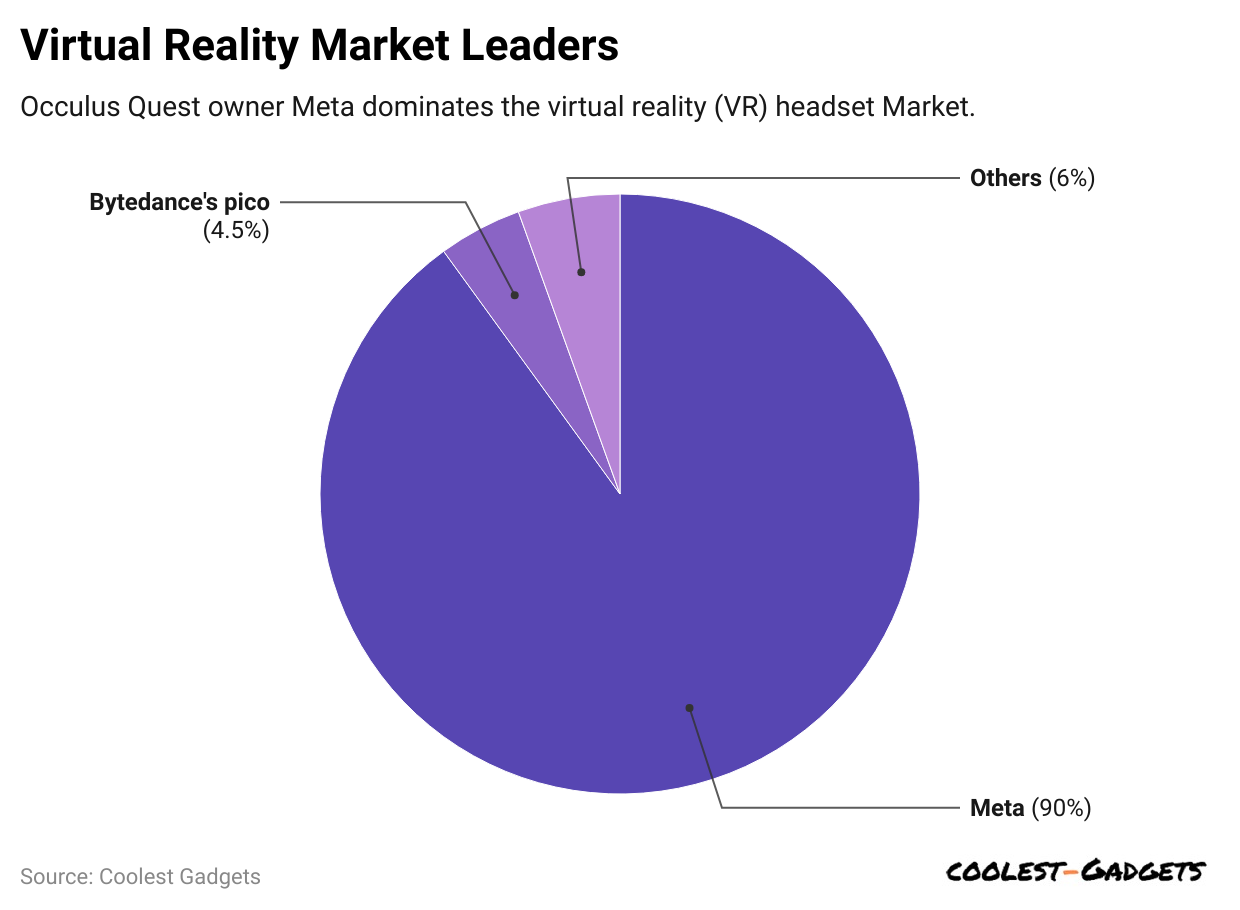 (Reference: enterpriseappstoday.com)
(Reference: enterpriseappstoday.com)
- The global revenue for augmented and virtual reality is projected to reach USD 72.8 billion by 2024.
- VR technology lets users perform actions in a simulated three-dimensional (3D) digital space.
- VR systems provide customizable environments, realistic images, and sensory feedback. Users usually interact with VR by wearing haptic gloves or VR headsets.
- The VR healthcare market is expected to grow to USD 4.9 billion by 2027.
- Virtual Reality Statistics stated that almost 56% of people believe virtual reality will have a positive impact on society.
- The global virtual reality market was worth USD 35 billion in 2023 and is projected to grow to USD 87 billion by 2030, with a compound annual growth rate (CAGR) of 13.8%.
- VR headset sales are expected to reach 11.2 million units worldwide in 2023 and rise to 14.31 million in 2024.
Virtual Reality Market Size Projection
- The global virtual reality market is expected to reach USD 44.7 billion by 2024.
- The number of active VR users around the world is projected to hit 171 million by 2018.
- The VR gaming market is estimated to grow to USD 45 billion by 2027.
- The global market for VR content and applications is forecasted to reach USD 41 billion by 2027.
- In China, the VR market is anticipated to reach USD 3.7 billion by 2021.
- According to Virtual Reality Statistics, the VR market in Europe is expected to grow to USD 24.06 billion by 2026.
- The total revenue for augmented and virtual reality is projected to hit USD 72.8 billion by 2024.
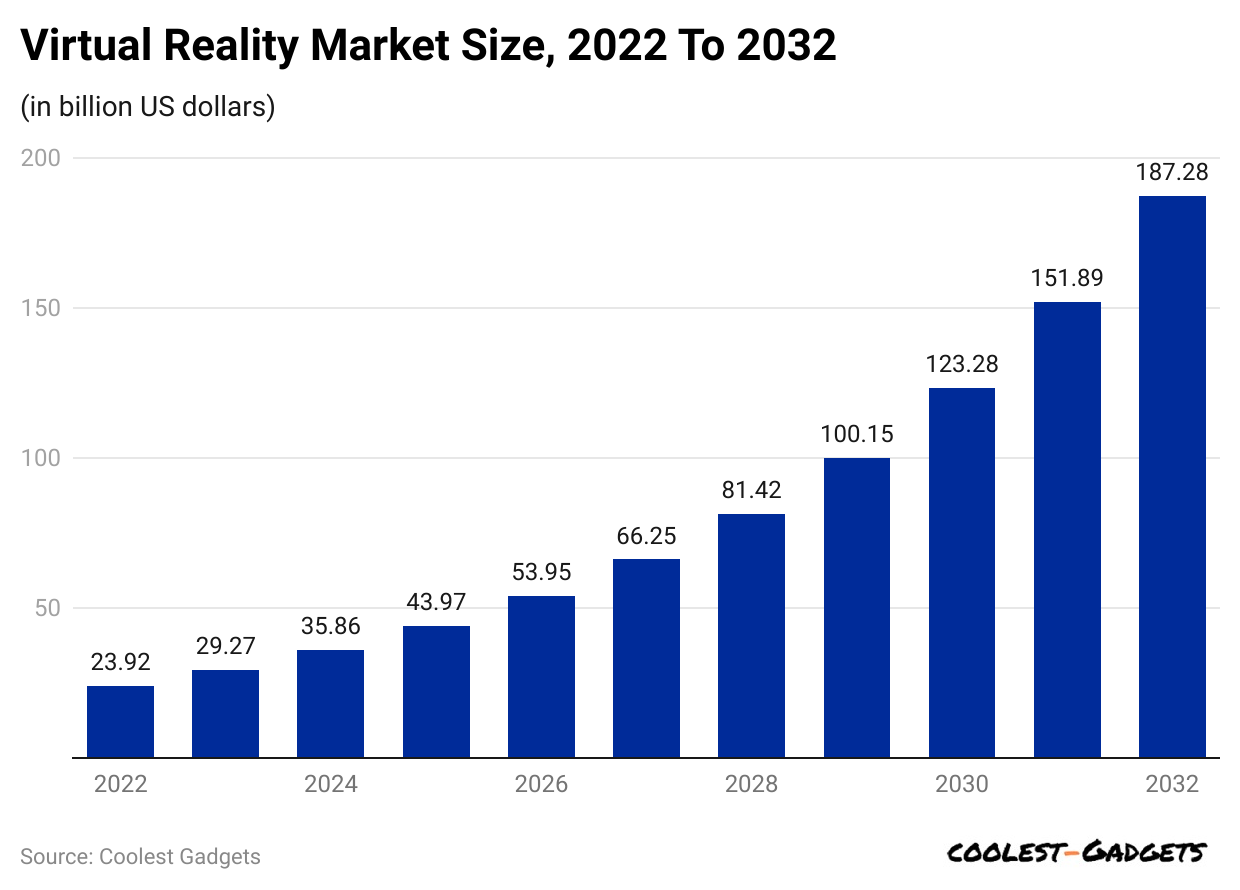 (Reference: grandviewresearch.com)
(Reference: grandviewresearch.com)
- The VR healthcare market is estimated to grow to USD 4.9 billion by 2027.
- In the US, the VR market is expected to reach USD 7.3 billion by 2027.
- Shipments of VR headsets are forecasted to reach 31.2 million units by 2023.
- The VR film industry is expected to increase from USD 179.1 million in 2018 to USD 1.06 billion by 2024.
- The VR market in the Asia-Pacific region is projected to reach USD 141.8 billion by 2026.
- The VR education market is expected to reach USD 700 million by 2025.
- Virtual Reality Statistics stated that the global VR market in healthcare is anticipated to grow to USD 5.1 billion by 2025.
- The VR retail market is predicted to reach USD 9.1 billion by 2025.
- The global VR content market is expected to exceed USD 40 billion by 2026.
- The market for VR headsets is anticipated to surpass USD 73 billion by 2027.
- The VR market in education is projected to reach USD 17.83 billion by 2026.
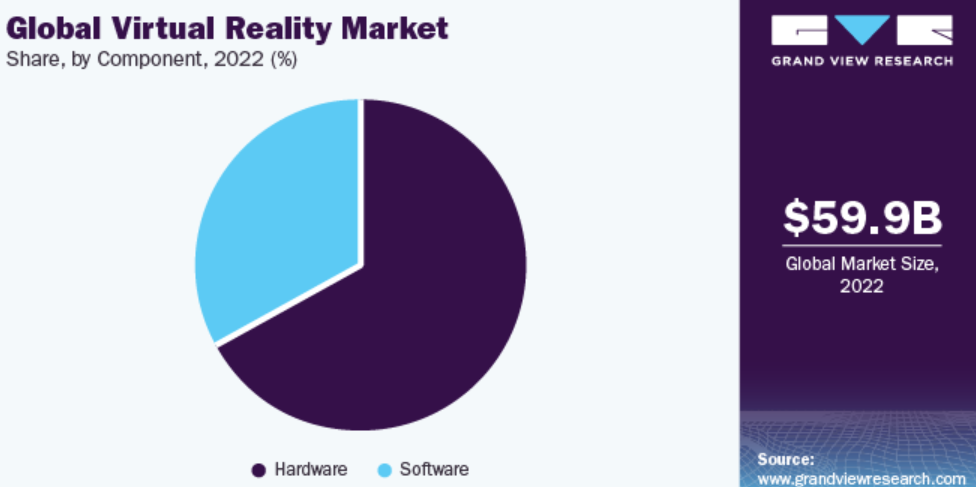 (Source: grandviewresearch.com)
(Source: grandviewresearch.com)
- The VR architecture market is expected to grow to USD 8.56 billion by 2026.
- In the UK, the VR market is expected to reach £3.2 billion by 2026.
- The global VR market for automotive applications is anticipated to exceed USD 53.7 billion by 2027.
- The VR gaming industry is projected to reach USD 43.57 billion by 2026.
- Virtual Reality Statistics stated that the global VR content market revenue is expected to surpass USD 130 billion by 2023.
- The VR sports market is anticipated to grow to USD 2.6 billion by 2026.
- The VR advertising market is forecasted to reach USD 19.9 billion by 2026.
You May Also Like To Read
- iPhone Vs. Android Statistics
- Google Pixel Smartphones Statistics
- iPhone vs Android Users Statistics
- Mesh Wi-Fi System Statistics
- Robots Statistics
- Western Digital Statistics
- Cloud Gaming Service Statistics
- Virtual Reality Headset Statistics
- AI in Robotics Statistics
- 3D Printers Statistics
- Smart City Statistics
- 3D Printing Statistics
Virtual Reality Adoption Rate Statistics
- About 53 million adults in the US own a VR system.
- More than 25% of teens (26%) have a VR device.
- An additional 14 million adults in the US are likely to buy one in the next six months.
- Virtual Reality Statistics stated that around 35% of VR users expect to spend more on VR in the upcoming six months.
- 66% of users feel that VR content must offer something special that traditional movies, TV, or games don’t provide to be worth the cost.
- Head-mounted displays (HMDs) accounted for 60% of revenue from VR devices in 2023.
- 13% of US households have at least one VR headset.
- The VR headset market is projected to reach $26.8 billion by 2027, up from USD 7.9 billion in 2021.
- VR headset sales jumped by 241.6% in the first quarter of 2024 alone.
- By 2024, more than 34 million VR headsets are expected to be in use.
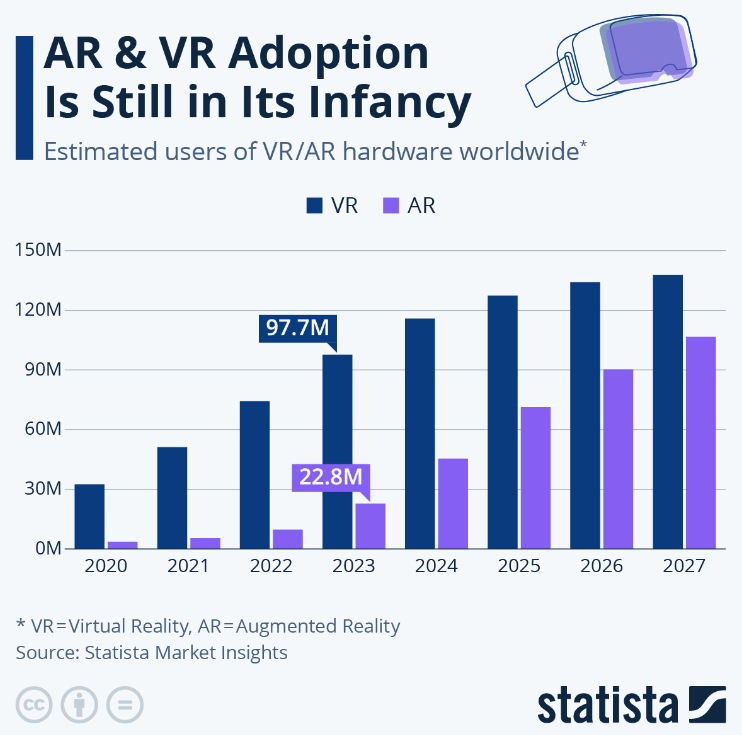 (Source: statista.com)
(Source: statista.com)
- 6 million AR/VR headsets are forecasted to be sold by 2026.
- Virtual Reality Statistics stated that 4 out of 10 consumers are excited about going to a VR concert.
- The main features consumers want in a VR headset include good image quality (52%), comfortable design (44%), high-quality sound (39%), and easy setup.
- Nearly 4 out of 10 Gen Z (37%) and millennial (38%) online users are very interested in attending virtual concerts of their favorite artists.
- More than a third of consumers are interested in using a VR headset to visit virtual museums (39%), socialize with friends and family (31%), or take fitness classes (32%).
- Almost half of shoppers are willing to pay more for products customized with immersive technologies.
Virtual Reality Headset Statistics
- VR headsets are important for creating immersive experiences by blocking out the real world. Key brands include Pico, Sony, and Meta.
- Meta’s Quest 3 and Apple’s Vision Pro are important products in the market. While Meta has a large share, Apple’s Vision Pro is likely to attract attention, even though it will have limited availability.
- The AR/VR headset market is expected to decline by 8.3% in 2023, with total shipments dropping to 8.1 million units. However, a strong recovery is expected in 2024, with a projected growth of 46.4% in headset shipments.
- New VR headsets may discourage some buyers because of rising prices, making them more accessible to wealthier consumers.
- In June 2023, Meta introduced the Meta Quest 3, a new VR and mixed-reality headset. Apple also launched its first VR product, the Apple Vision Pro, in June 2023. This device lets users switch between augmented reality (AR) and VR.
| Product Category | 2023 Shipment | 2023/2022 Growth | 2027 Shipments | 2027/2026 Growth | 2023-2027 CAGR |
|
Virtual Reality |
7.6 | -10.7% | 21.9 | 26.7% |
30.1% |
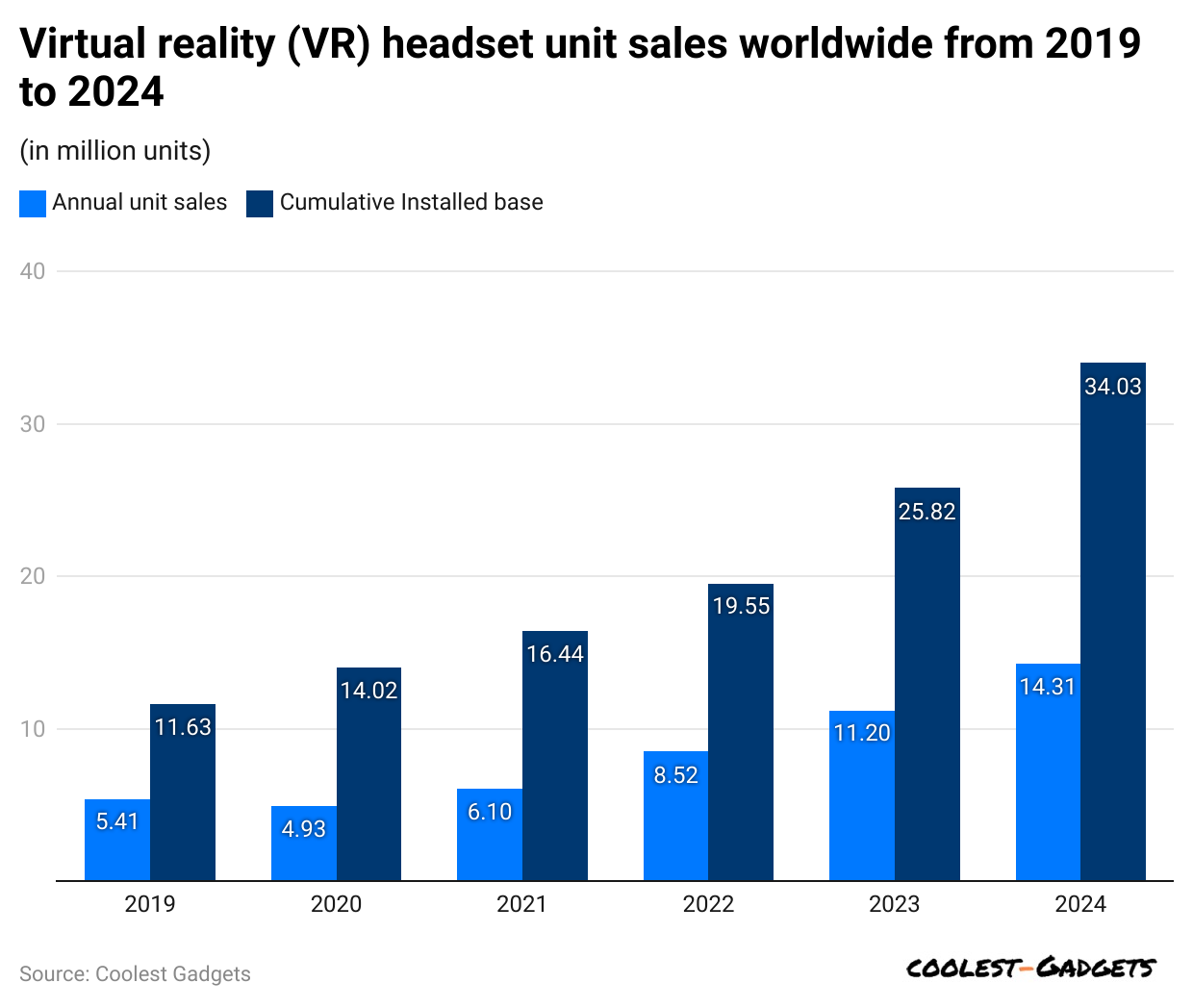 (Reference: coolest gadgets.com)
(Reference: coolest gadgets.com)
- In 2023, sales of VR headsets reached 11.2 million units, bringing the total number of units in use to 25.82 million.
- Annual sales are expected to rise to 14.31 million units by 2024, and the total number of installed units is projected to reach 34.03 million.
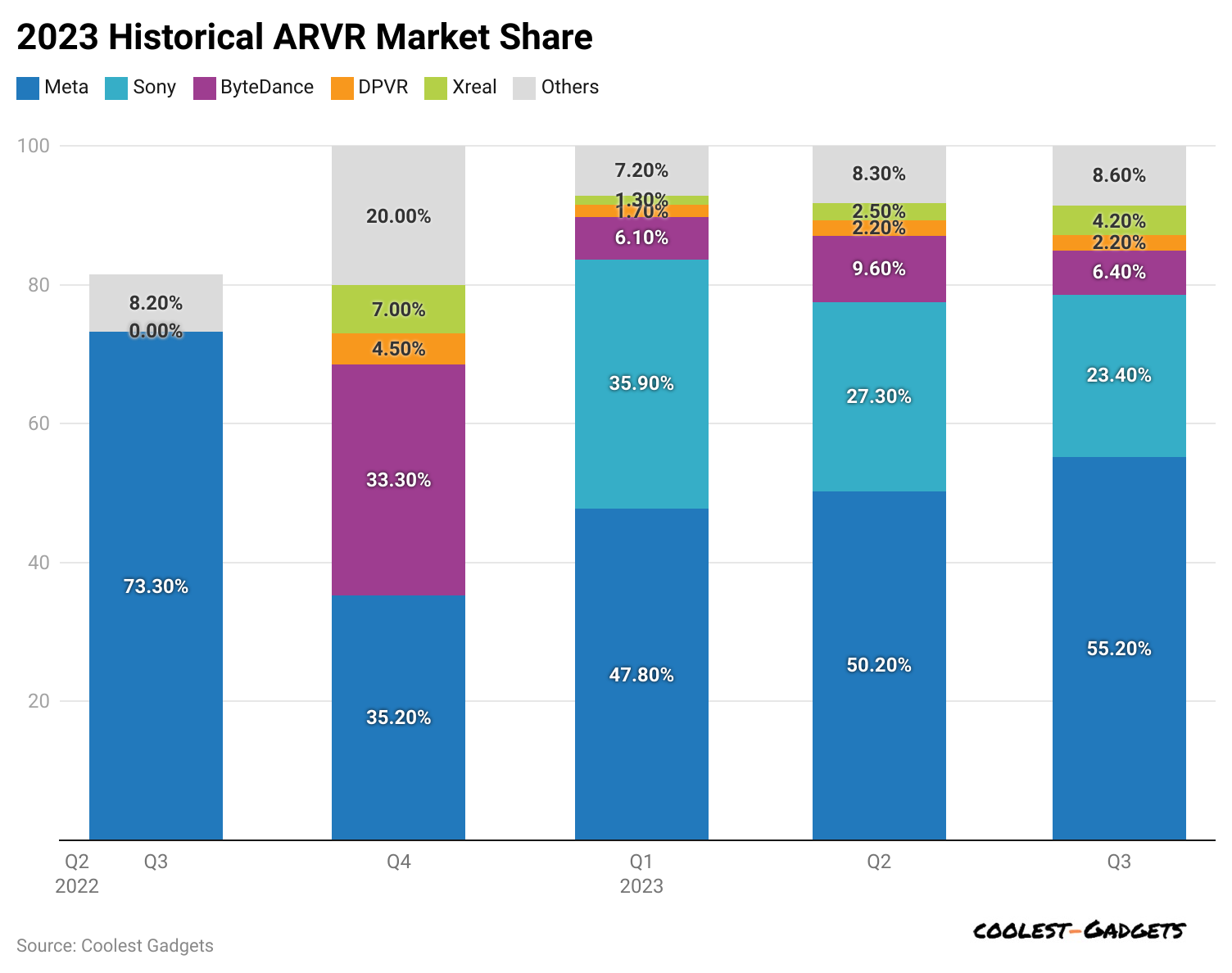 (Reference: coolest gadgets.com)
(Reference: coolest gadgets.com)
- In the first quarter of 2023, Meta was the top AR/VR headset company globally, holding a market share of 47.8%.
- Virtual Reality Statistics stated that by the second quarter of 2023, Meta’s share rose to 50.2%.
- The market shares of other companies for the first and second quarters of 2023 are as follows:
#1. Sony: 35.9% and 27.1%
#2. ByteDance: 6.1% and 9.6%
#3. DPVR: 1.7% and 2.2%
#4. Xreal: 1.3% and 2.5%
#5. HTC: 1.4% and 2.0%
#6. Others: 5.7% and 6.4%
- Global shipments of AR and VR headsets are expected to decline by 8.3% in 2023, totaling 8.1 million units.
- Following is the sales volume growth of VR headsets from 2022 to 2027:
| Year | Estimated sales volume growth of VR Headsets |
|
2022 |
34.4% |
| 2023 |
13.7% |
|
2024 |
8.5% |
| 2025 |
5.5% |
|
2026 |
6.5% |
| 2027 |
0.6% |
- By the end of the third quarter of 2023, Meta recorded the highest market share in shipments, reaching 55.2%.
- The VR headset market is projected to have shipments of 7.6 million units by December 2023 and grow to 21.9 million units by the end of 2027.
You May Also Like To Read
- Network Attached Storage (NAS) Statistics
- Hacking Statistics
- Augmented Reality Glasses Statistics
- Virtual Reality Treadmill Statistics
- Uninterruptible Power Supply Devices (UPS) Statistics
- Social Engineering Statistics
- Podcast Statistics
Virtual Reality in Education And Training
- The virtual reality (VR) education market is expected to grow significantly, from USD 4.40 billion in 2023 to USD 28.70 billion by 2030.
- This growth is projected to happen at a strong compound annual growth rate (CAGR) of 30.7% during this time.
- VR is changing how we learn. According to Virtual Reality Statistics, training can boost learning effectiveness by 76% compared to traditional methods.
- Employees can learn four times faster in VR courses than in regular classrooms, revolutionizing workforce training.
- A study by VirtualSpeech found that 95% of participants who practiced in VR said it helped them prepare better for real-life situations at work, like sales pitches and negotiations.
- Learners who experience VR training show a 275% increase in confidence to apply what they’ve learned, which is 40% more than traditional classroom training and 35% more than e-learning. This shows how effective VR is in reinforcing knowledge. (PwC)
- Learners using VR report feeling 3.75 times more emotionally connected to the training content than those in traditional classrooms and 2.3 times more connected than e-learners. This emotional connection can help with better retention and use of knowledge.
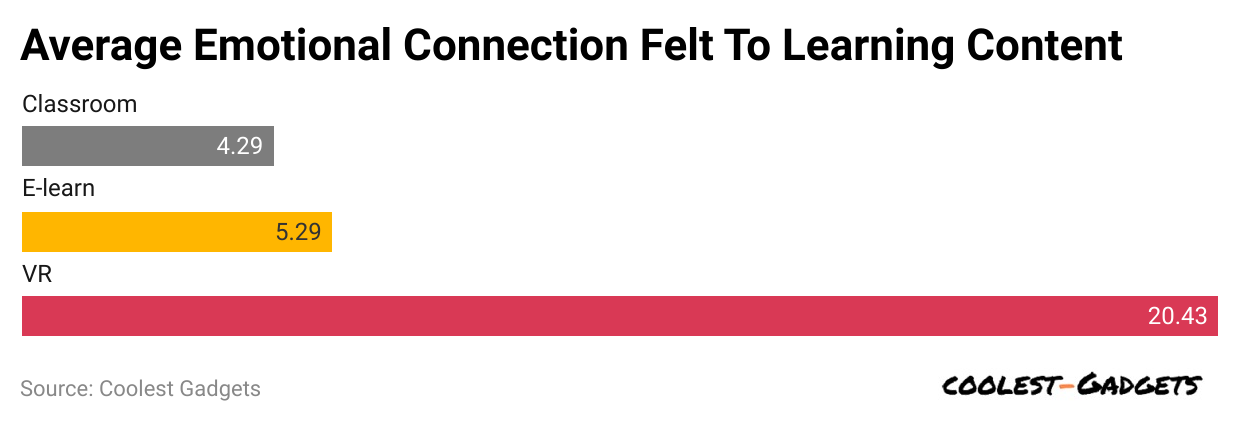 (Reference: virtualspeech.com)
(Reference: virtualspeech.com)
- In a VR learning environment, distractions are greatly reduced. VR fully engages users in simulations, keeping their attention and leaving no room for multitasking.
- As a result, employees trained in VR are up to four times more focused than those in e-learning and 1.5 times more focused than those in classrooms. This increased focus helps improve learning outcomes.
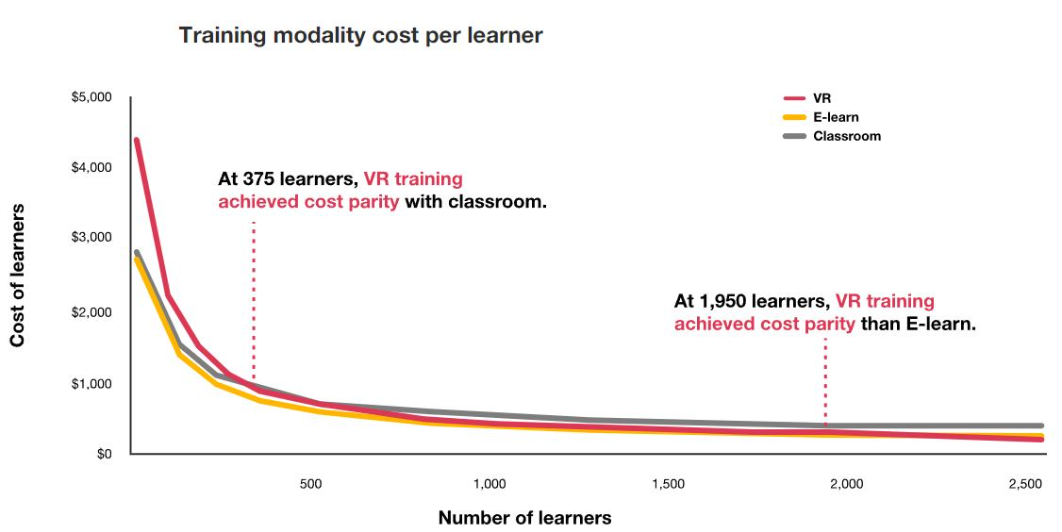 (Source: virtualspeech.com)
(Source: virtualspeech.com)
- Immersion in a VR experience often leads to deeper training results, making learning more effective and impactful.
- VR training becomes cost-effective compared to classroom learning when there are 375 learners. With 3,000 learners, VR training is 52% cheaper than classroom training.
- At 1,950 learners, the cost of VRVR training is the cost of e-learning. These findings highlight how cost-efficient VR training can be, especially when used on a larger scale.
Industry Affected By the Introduction of Virtual Reality
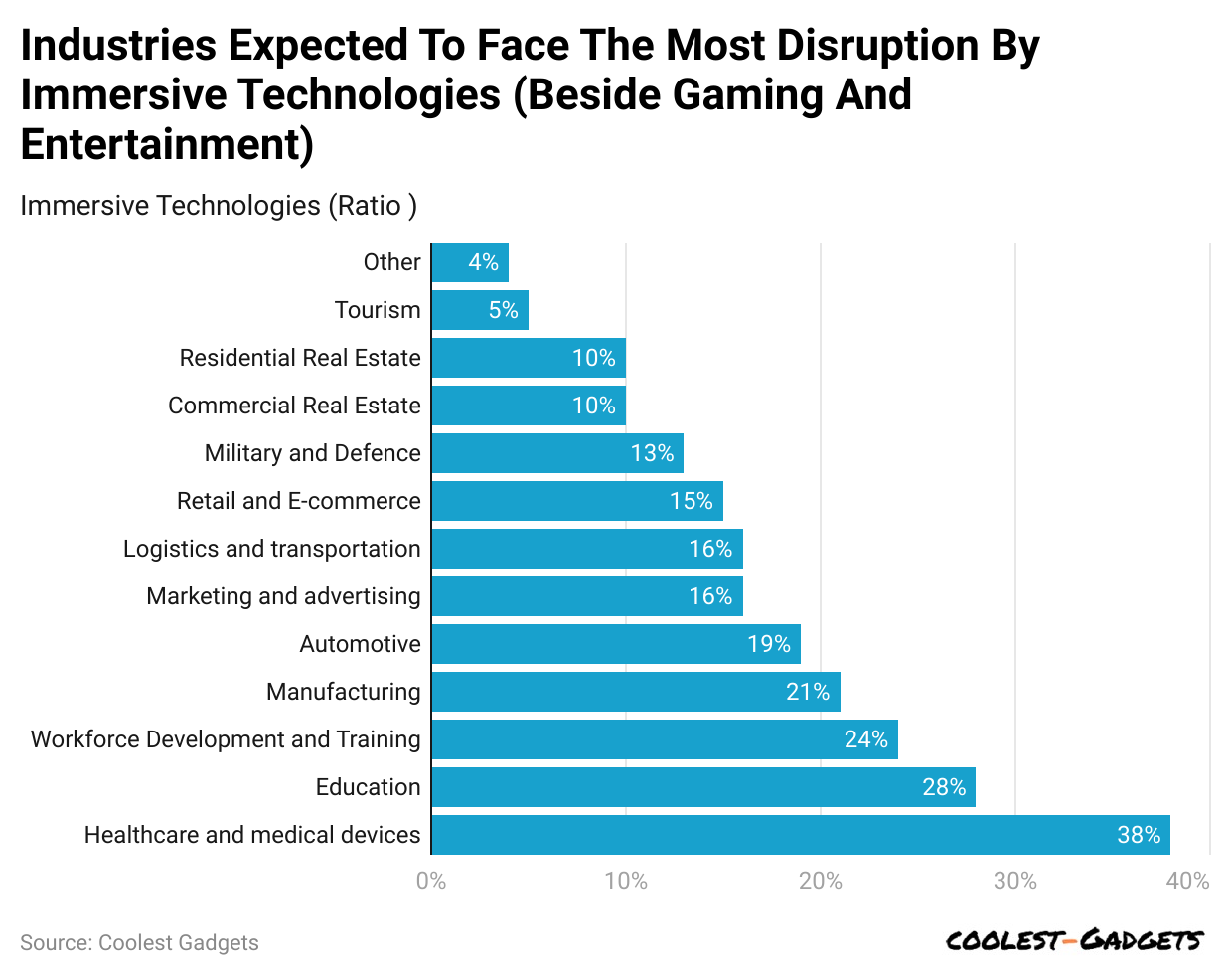 (Reference: smarttek.solutions)
(Reference: smarttek.solutions)
|
Healthcare and medical devices |
38% |
| Education |
28% |
|
Workforce Development and Training |
24% |
| Manufacturing |
21% |
|
Automotive |
19% |
| Marketing and advertising |
16% |
|
Logistics and transportation |
16% |
| Retail and E-commerce |
15% |
|
Military and Defence |
13% |
| Commercial Real Estate |
10% |
|
Residential Real Estate |
10% |
| Tourism |
5% |
|
Other |
4% |
Virtual Reality Statistics by Demographics
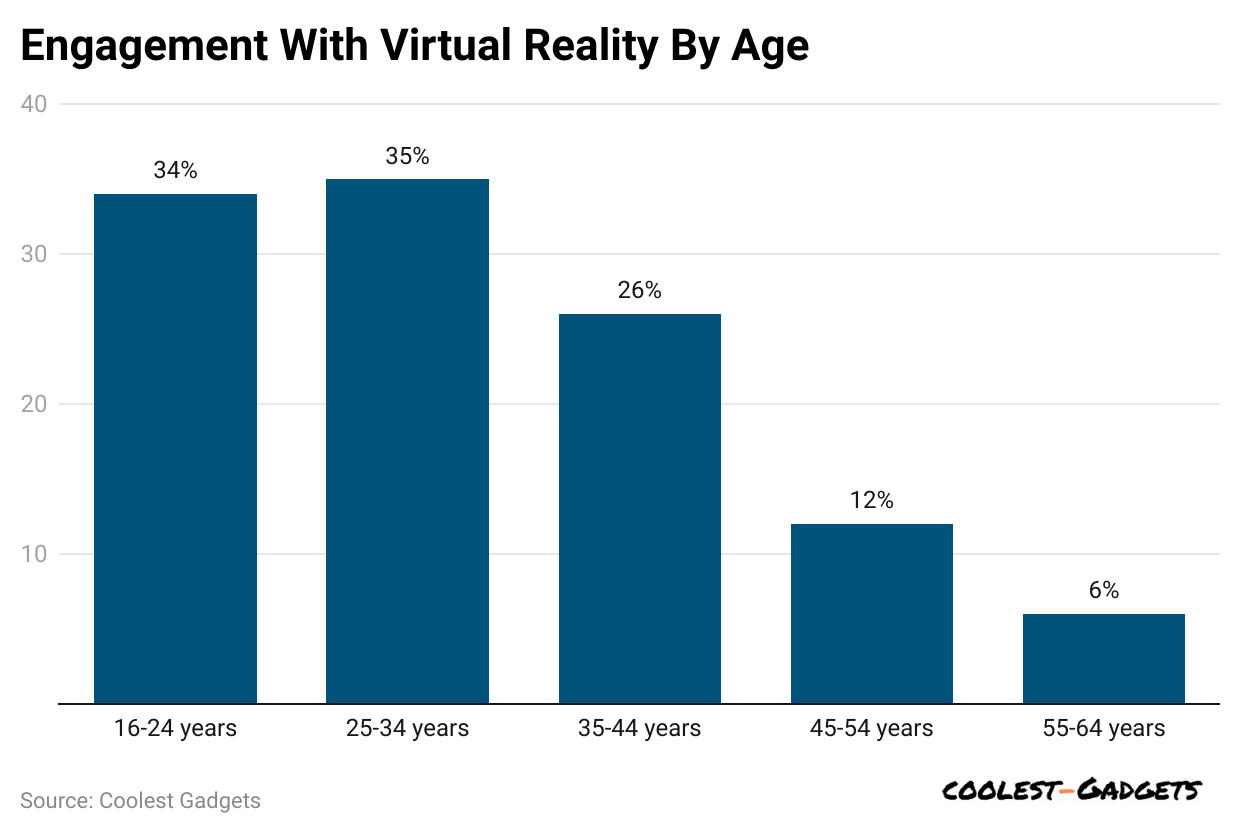 (Reference: enterpriseappstoday.com)
(Reference: enterpriseappstoday.com)
- As of 2023, the main users of VR in the US are 30% millennials and Gen Z, followed by 26% from Gen X and 13% from Boomers.
- Many US VR users are excited about attending virtual music concerts, with 37% of Gen Z and 38% of millennials showing interest.
- Virtual Reality Statistics state that one in three Gen Z shoppers prefers to purchase products from virtual stores.
- In 2022, VR engagement by age revealed that 35% of users were between 25 and 34 years old, 34% were between 16 and 24, 26% were between 35 and 44, 12% were between 45 and 54, and 6% were between 55 and 64.
- Regarding VR motioDataf, males experience it frequently, 13.VR motion sickness rarely, 29% sometimes, and 50% never. For females, 22.8% experience it frequently, 22.6% rarely, 20.2% sometimes, and 34.7% never.
Virtual Reality in the Healthcare Market
- Virtual reality (VR) in healthcare has grown rapidly, increasing from a USD 3.1 billion industry in 2023 to USD 25 billion by 2030.
- The annual growth rate (CAGR) is 34.9%, or, by other measures, an even stronger 39.4%.
- Deloitte reports that the VR segment of the health tech market generated USD 7 billion by the end of 2023, showing a nearly 50% increase in just one year.
- The North American VR healthcare market reached USD 890 million and is expected to continue expanding and become a major part of the global market.
- Europe and Asia-Pacific markets are also expected to grow, according to Virtual Reality Statistics.
- 82% of people agree that augmented and virtual reality is making it easier to access healthcare.
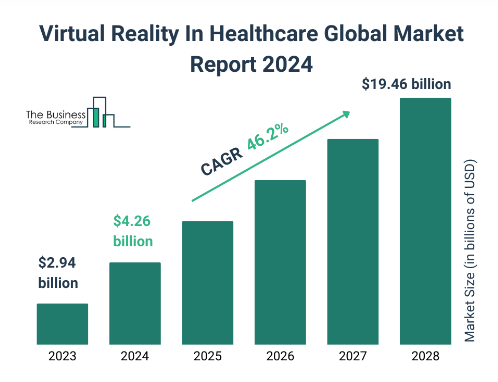 (Source: thebusinessresearchcompany.com)
(Source: thebusinessresearchcompany.com)
- 83% believe these technologies will create new ways to interact and communicate about health, as per Virtual Reality Statistics.
- 84% think it’s important for their organization to use augmented and virtual reality solutions.
- 72% agree that extended reality will become common and impact almost every industry in the next five years.
- Patients are also supportive of this change. Before COVID-19, virtual care was slow to gain traction, but the pandemic changed people’s attitudes, leading to greater acceptance of digital healthcare.
- As stated in Virtual Reality Statistics, 62% of patients are now open to virtual health and wellness advice.
Future Of Virtual Reality Statistics
- The Augmented Reality (AR) market was expected to make between USD 69.3 billion and USD 73.4 billion in revenue by 2023.
- It’s estimated that 500 million VR headsets will be sold by 2025.
- By 2025, every worker in a company will likely receive VR training about safety and labor protection, which could lower risks by 30%.
- Using VR in engineering can reduce the time needed for model design by 10% and construction time by 7%.
- By 2025, VR is expected to account for only 5-15% of the total gaming industry.
- Additionally, 53% of consumers expressed interest in using AR or VR within the next three months.
Conclusion
Virtual Reality (VR) is growing fast and becoming more popular in many industries. From gaming and education to healthcare and business, VR is creating new opportunities and improving experiences. More companies are investing in VR, and the technology is getting better every year. With increasing demand, the future of VR looks very bright. As more people use VR for work and entertainment, its impact will continue to grow. This technology is not just a trend—it is shaping the way we learn, play, and connect in the digital world.
We can only wait to see what the future brings for this technology. We have shed enough light on Virtual Reality Statistics through this article.
Sources

Saisuman is a talented content writer with a keen interest in mobile tech, new gadgets, law, and science. She writes articles for websites and newsletters, conducting thorough research for medical professionals. Fluent in five languages, her love for reading and languages led her to a writing career. With a Master’s in Business Administration focusing on Human Resources, Saisuman has worked in HR and with a French international company. In her free time, she enjoys traveling and singing classical songs. At Coolest Gadgets, Saisuman reviews gadgets and analyzes their statistics, making complex information easy for readers to understand.







